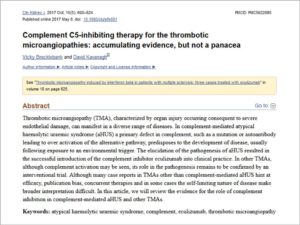
It can be a struggle to find information about medical conditions if you’ve been diagnosed with a rare disease, and more so if you have multiple medical issues which impact treatment or quality of life. Puzzled about how to find disease-specific medical information and current research articles? You’re not alone. Long gone are the days of every doctor’s office sporting a brochure rack, which today is often replaced with online information since research and knowledge bases are continually evolving. What has not changed is the need of rare disease patients and their caregivers to obtain updated, accurate information from reliable and objective sources.
In keeping with the aHUS Alliance mission of providing assets and information for the international atypical HUS community, we offer this “How To” guide on search basics to help you locate medical publications with up-to-date information. Since aHUS can affect multiple organs and body systems, we’ll guide you through one type of search technique with steps on how to conduct a simple literature review of aHUS publications. Rely on your physician and care team for medical advice, but realize that patients and their caregivers can take responsibility for being educated participants in healthcare discussions by learning more about their medical conditions. Learning how to search for current journal articles and research could be especially helpful if the treating physician has also diagnosed other medical issues along with atypical HUS.
As if it’s not difficult to be diagnosed with a very rare and life-threatening disease, atypical HUS patients face the additional barrier of having disease-specific research listed under a variety of spellings and names. To illustrate, searching for aHUS medical information under the phrase “atypical hemolytic uremic syndrome” on NCBI PubMed website (NIH/US Library of Medicine) yields 1290 search results, which can be sorted further by publication date (sidebar, I year to custom range) or article attributes (selecting Open Access will provide the full text). The British spelling is “atypical haemolytic uraemic syndrome”, which provides a broader group of 2095 search results. Look at the top of your computer screen after clicking this hyper link and you will find a plus sign between each word: https://www.ncbi.nlm.nih.gov/pmc/?term=atypical+haemolytic+uraemic+syndrome . Compare that to a search on the same site for “atypical HUS” which yields merely 1244 results while “aHUS” which yields only 855 search results, some of which are not about this disease but refer to research done in the Swedish city of Åhus.
If you’re not thoroughly confused yet, look at the titles of those search results and you’ll note that many publications do not even include atypical HUS (or a spelling variant) in its title. Instead you’ll find articles and research with headings which might instead include these or similar terms: thrombotic microangiopathy, complement mediated, HUS, D- HUS, complement activation or dysregulation, or common genetic variants (such as Factor H). Atypical HUS treatment can be included in articles related to infection-induced HUS, mentioned in articles related to eculizumab therapy, or in articles related to differentiating aHUS from other medical conditions. (Link to the aHUS Alliance blog on this topic).
We agree, finding information about aHUS can be frustrating. Here is a sample literature search using an actual situation that the aHUS Alliance global team recently received by email, from a USA family wishing to find aHUS research for a loved one whose physician additionally diagnosed lupus as a secondary condition to the primary diagnosis of atypical HUS.
Step by step, here’s one approach for a patient or caregiver to look up the latest medical articles about aHUS, or regarding aHUS plus a second interest area (specific organ, additional medical condition, genetic variant, or complicating issue). People living with atypical HUS may be interested in diet, dialysis, transplants, aspects of managing chronic kidney disease, or other issues but this basic search technique still will help you explore topics across a wide variety of medical journals, articles and research.
Step 1: Look for the broadest range of information about your topic of interest, in this case we’ll use “atypical haemolytic uraemic syndrome”, which provides 2095 search results. (Click this hyperlink provided to quick-start your review of aHUS publications.) The website’s search bar will appear as illustrated here.

Step 2: Keeping the words “atypical haemolytic uraemic syndrome” in the search bar, now add the specific topic you wish to find which in our sample case would be “plus lupus”. Using the plus sign or “+ lupus” will yield the same 141 search results , indicating that there are 141 articles or research papers about atypical HUS that also include some mention of lupus. (It won’t matter if you type in the word ‘lupus ‘first or second, since a combination of the two words will still yield 141 results.)
Step 3: Now you’ll have a variety of options, with choices to make that are highly individual to people and circumstances. If you’re a bit intimidated by wading through 141 documents rich with medical terms and containing some degree of information on aHUS and lupus, look to the sidebar at the left of your computer screen. Under “Publication Date”, you have the option to limit your search to the last 5 years of publications which will allow you to focus on 86 documents. Atypical HUS research has expanded greatly in the last 5 years, with new information regarding genetics, future aHUS investigational drugs under development, information on eculizumab therapy for treatment of aHUS, and multi-organ involvement. (Click here for our resource: aHUS Alliance Sept 2017 Key Facts and Information, see pg 5 for our latest drug R & D chart)
Step 4: It’s time to dig deeper, actually screening each publication for the key terms and information targets. Unless you wish to scan all documents visually, it’s best to use a tool or function that highlights the specific word or terms. At this point it’s more efficient to rely on your computer’s “Find” functions, which differ according to operating systems and software such as Adobe Reader or the Google Chrome browser for Mac or PC. (Check out this link FMI on options.) Most publications have headings, which often provide readers some direction about how the document’s information has been organized by the authors.
Look at the recent article ‘Complement C5-inhibiting therapy for the thrombotic microangiopathies: accumulating evidence, but not a panacea’ written by Vicky Brocklebank and David Kavanagh, in an Oct 2017 edition of the Clinical Kidney Journal (online May 2017). Most medical journal articles and research papers begin with an Abstract (overview) about the key points addressed in the publication. Under the Abstract section find Key Words, which usually target the focus of the document, and where you’d hope to find terms relevant to your search topic. Letters to the Editor and opinion pieces will usually have a different structure and appearance, since they are written to serve a different function.

Journal articles or research papers may be available in full text form, allowing the public to read the entire document, or might appear as an abstract only. Some journals invite patients and advocates to sign up and gain access to certain publications, and the public may be able contact the document’s lead author to request access. In all cases, it’s both a courtesy and a legal obligation to respect intellectual property and copyright laws. Do you only want to limit your search only to full text articles? There’s a search option at the top of the left sidebar to filter and include only those publications which are Open Access. Find it under selections for Article Attributes. If you come across an Abstract that seems intriguing, mention it to your medical team as an article of interest since most physicians have access to medical journals and research sites through their practice, academic institution, or hospital.
Step 5. Look up medical terms and phrases that seem to crop up often in the literature. Medical jargon can be tough to wade through, so keep a disease-specific reference list or resource on hand. We recommend the NIH GeneReview ®for aHUS (Noris M et al, updated June 2016), since medical terms appear in context and readers can click hyperlinks within this resource for both definitions and for key research articles about this rare disease.
While the technique is quite simple, these 5 steps can help patients and caregivers keep updated about medical advancement and research topics of interest to them. Information about atypical HUS can difficult to find, which is why the aHUS Alliance provided people and national patient organizations an accurate resource with its international 2017 aHUS Fact Sheets (one is a brief printable sheet, and the other an 11 page detailed pdf document to include links to key information). Atypical hemolytic uremic syndrome is a life-threatening disease that affects an estimated 2 people per million (Maga T, Smith R et al, 2010), although some research offers lower or higher aHUS patient population estimates. A quick math calculation given the world population of 7.5 billion, or 7,500 million, leads to a rough guess of about 15,000 people with aHUS worldwide. This small patient population means it can be difficult to find disease-specific medical information and research about aHUS (or SHUa in languages such as French or Spanish).
The aHUS Alliance global action team has conducted its own reviews of medical information, using this same simple approach, to bring you articles on aHUS and pregnancy, sleep, skin, vision, cognitive issues (aka brain fog), multi-organ involvement and other topics. With rapidly changing information about atypical HUS, it’s important for patients and their caregivers to search regularly for updated medical information, new clinical trials and data, and current research. As aHUS patients, parents, or caregivers for loved ones with atypical HUS ourselves, our international team of aHUS Alliance volunteers have found that the best place to find a helping hand is at the end of our own arms. Be proactive, get informed, stay connected …. and now you too can conduct a basic search to review medical literature for relevant, specialized information about this rare disease.
A Useful Resource – from the Patient Empowerment Network
How to Read and Understand a Scientific Paper

Learn more about the aHUS Alliance:
A key focus of the aHUS Alliance website is to increase connectivity in the aHUS arena, and to serve as a platform to provide atypical HUS information and resources of global interest. Creating disease-specific articles and assets for aHUS patient organizations and advocates worldwide, the aHUS Alliance also serves as an international network for collaborative efforts. We encourage you to visit our aHUS Alliance list of countries with patient organizations and aHUS advocacy outlets in nations around the world, which supports and connects communication to highlight each nation’s patient voice and provides insight into the priorities of each patient organization.
Click the link to view our About the aHUS Alliance page.
View the aHUS Alliance network of aHUS Clinicians & Investigators .
aHUS Alliance – Press Kit
aHUS Alliance – Info Centre: Document List

